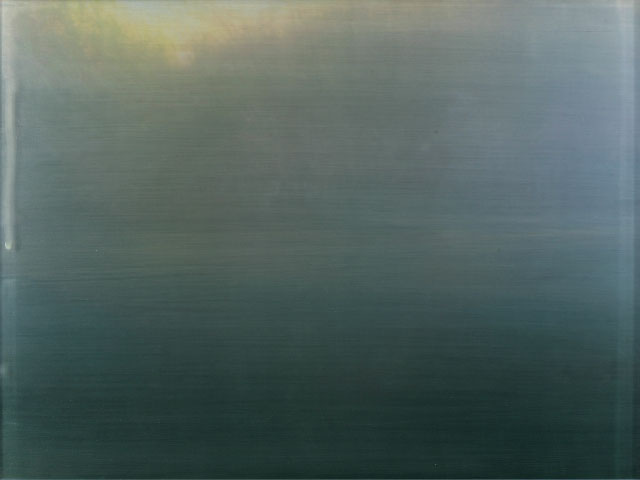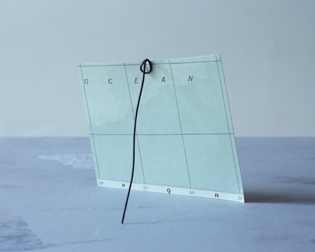January at PDX Contemporary Art
Monday, January 5, 2009
This January PDX Contemporary Art presents three beautiful & engaging shows

MEGAN MURPHY
PORCELAIN
JANUARY 5 - JANUARY 30, 2010
RECEPTION FOR THE ARTIST WEDNESDAY, JANUARY 6 6:00PM - 8:00PM
I would include Megan Murphy’s paintings in a volume of concrete poetry. They establish a material condition for language, as do the carefully tended fonts and page placement and binds of concrete poetry. They are kin to Paterson, William Carlos Williams’s monumental poem of his hometown in New Jersey. Williams layered newspaper writing, gossip, anecdotes, geology, and human history around the central figure of the passaic river flowing past a decisive extrusion of rock that locals called “the ogre,” which the ceaseless motion of the passaic could never erode.
Williams was content to use language as he found it (plain words; often very old ones) and the book as a form, confident that the conspiracy of minds set into motion by his words
on the page would give this history its life and meanings. In her paintings, Megan Murphy confronts an equally rich history (a 19th-century massacre of chinese laborers on a thin shore of the snake river, in what is now oregon) but finds the language of its telling inadequate. More, the social history of this story erodes its larger meanings, separating men from men and humanity from the earth. History tells only the meager facts, bit by bit. so, what to do? How to reconstitute the larger story that language has torn apart?
Murphy does not abandon words, but fashions a material laboratory for the creation of new ones—layering, sanding, engraving, painting—with glass, film, pigment, oil, acetate, and other materials. alchemists did this. John Dee made a singular “monad” by grafting symbols from multiple, esoteric histories into one unified thing. Dee’s monad could not be pronounced; instead, it was to be studied and dwelt in.
Megan Murphy brings material together with labor to make language. Her paintings are words—opaque, archival, unstable, conspiratorial. A suite of three are titled Suspend, Echo, and Cease. But the paintings are not these words so much as they are their own new ones, graven but unpronounceable: monads to be studied and dwelt in. They suggest that
geology, human history, and their telling are (or should be) bound together in a single ecology.
Murphy is not corralling wild meanings into words, so much as she is freeing language from its narrow instrumentality. Her paintings reveal to us that words are never a stable artifice, standing above or outside our bodies and place; language itself is geological—accretive; sedimentary; congealing—and it is human, an exhalation as much the consequence of our lived history as is any life or death.
-Matthew Stadler 2009
Williams was content to use language as he found it (plain words; often very old ones) and the book as a form, confident that the conspiracy of minds set into motion by his words
on the page would give this history its life and meanings. In her paintings, Megan Murphy confronts an equally rich history (a 19th-century massacre of chinese laborers on a thin shore of the snake river, in what is now oregon) but finds the language of its telling inadequate. More, the social history of this story erodes its larger meanings, separating men from men and humanity from the earth. History tells only the meager facts, bit by bit. so, what to do? How to reconstitute the larger story that language has torn apart?
Murphy does not abandon words, but fashions a material laboratory for the creation of new ones—layering, sanding, engraving, painting—with glass, film, pigment, oil, acetate, and other materials. alchemists did this. John Dee made a singular “monad” by grafting symbols from multiple, esoteric histories into one unified thing. Dee’s monad could not be pronounced; instead, it was to be studied and dwelt in.
Megan Murphy brings material together with labor to make language. Her paintings are words—opaque, archival, unstable, conspiratorial. A suite of three are titled Suspend, Echo, and Cease. But the paintings are not these words so much as they are their own new ones, graven but unpronounceable: monads to be studied and dwelt in. They suggest that
geology, human history, and their telling are (or should be) bound together in a single ecology.
Murphy is not corralling wild meanings into words, so much as she is freeing language from its narrow instrumentality. Her paintings reveal to us that words are never a stable artifice, standing above or outside our bodies and place; language itself is geological—accretive; sedimentary; congealing—and it is human, an exhalation as much the consequence of our lived history as is any life or death.
-Matthew Stadler 2009

JOHN MANN
FOLDED IN PLACE
PDX ACROSS THE HALL
JANUARY 5 - JANUARY 30, 2010
RECEPTION WEDNESDAY, JANUARY 6 6:00PM - 8:00PM
Informed by the varied ways that photography, mapping, drawing and sculpture have each tried to describe the landscape, Folded in Place highlights the abstraction of the landscape traditionally offered by these means, while creating a tangible photographic “place. We are shown a landscape that is simultaneously understood and unknown, a landscape in which the map obtains a new geography of its own.
John Mann was born in the American East, raised in the Midwest, schooled in the West and now lives in Tallahassee, FL.

SHAWN RECORDS
Stupid People Love High Places: Recent Photographs of the World
PDX WINDOW PROJECT
JANUARY 5 - JANUARY 30, 2010
24hrs a day, 7days a week
The Japanese have an expression: "Stupid People Love High Places." Recently, Shawn Records had the opportunity to circumnavigate the globe in just 18 days, with stops in Paris, London, Madrid, and Tokyo. PDX Gallery, through its Window Project, is proud to present "Stupid People Love High Places," a slideshow of photographs, primarily drawn from Records's recent travels.
Utilizing the slideshow format we are presented with big places and small moments, with no overt umbrella of meaning, narrative, or context. Records presents these photographs simply as he's made them- as scraps that he's recently picked up along the way- souvenirs and treasures; shiny, exotic rectangles from around the globe.
Utilizing the slideshow format we are presented with big places and small moments, with no overt umbrella of meaning, narrative, or context. Records presents these photographs simply as he's made them- as scraps that he's recently picked up along the way- souvenirs and treasures; shiny, exotic rectangles from around the globe.